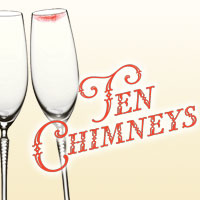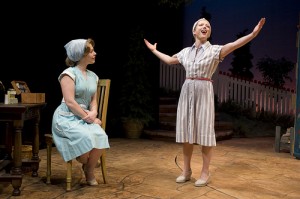ALL ABOUT ALFRED AND LYNN
Ten Chimneys is the name of the estate near Madison, Wisconsin, where the famous American husband-and-wife acting team of Alfred Lunt and Lynn Fontanne retreated annually to prepare for their season on the American stage. The estate is now a major tourist attraction, a monument to the lives and careers of the Lunts. Now another monument exists to celebrate the Lunts, a literate, funny, poignant, and even educational play by Jeffrey Hatcher entitled Ten Chimneys, now receiving its local premiere at the Northlight Theatre in what may be the most stylish Chicagoland production of the season.
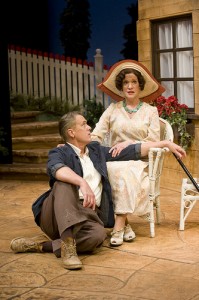 The play takes place during the late 1930’s, when the Lunts stood atop the American theatrical pyramid. They knew everyone in trans-Atlantic theater and Ten Chimneys was a standard destination for Beautiful People, stars like Noel Coward, Laurence Olivier, and Katharine Hepburn, but playwright Jeffrey Hatcher hasn’t simply written an exercise in nostalgia by crowding his play with impersonations of famous personalities from the theater world. There are only seven characters – the Lunts, Alfred’s mother Hattie, his half-sister Louise and half-brother Carl, and actors Sidney Greenstreet and Uta Hagen. The play takes place inside and outside the main estate house where the Lunts are rehearsing their revival of Anton Chekhov’s The Seagull that’s headed for Broadway and a subsequent national tour (a quasi-epilogue ends the play after the end of World War II in 1945).
The play takes place during the late 1930’s, when the Lunts stood atop the American theatrical pyramid. They knew everyone in trans-Atlantic theater and Ten Chimneys was a standard destination for Beautiful People, stars like Noel Coward, Laurence Olivier, and Katharine Hepburn, but playwright Jeffrey Hatcher hasn’t simply written an exercise in nostalgia by crowding his play with impersonations of famous personalities from the theater world. There are only seven characters – the Lunts, Alfred’s mother Hattie, his half-sister Louise and half-brother Carl, and actors Sidney Greenstreet and Uta Hagen. The play takes place inside and outside the main estate house where the Lunts are rehearsing their revival of Anton Chekhov’s The Seagull that’s headed for Broadway and a subsequent national tour (a quasi-epilogue ends the play after the end of World War II in 1945).
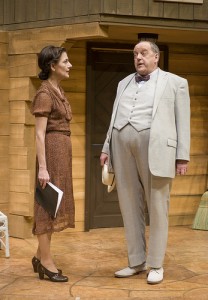 The first act introduces the audience to the complex personalities and tensions among the Lunt family: Hattie resents Lynn because the wife encroaches on the mother’s smothering love for her son. Lynn naturally resents the mother and they go back and forth in volleys of scintillating bitchy dialogue. When Lynn goes off to get the mail, Hattie comments “Look at her run. You’d think someone had sent her a mirror.”
The first act introduces the audience to the complex personalities and tensions among the Lunt family: Hattie resents Lynn because the wife encroaches on the mother’s smothering love for her son. Lynn naturally resents the mother and they go back and forth in volleys of scintillating bitchy dialogue. When Lynn goes off to get the mail, Hattie comments “Look at her run. You’d think someone had sent her a mirror.”
But the play extends way beyond verbal cleverness for its own sake—Ten Chimneys is about the theater. Much of the play occurs during a rehearsal of The Seagull, providing fascinating insights into scene and character development, and how intonation and gesture illuminate a character or a moment. The Lunts were famous for their obsessive rehearsing and one of the play’s best scenes shows the couple going through a half dozen interpretations of a particular passage in a matter of a few minutes, allowing the audience a prismatic view of how many different ways a few lines of dialogue can be performed.
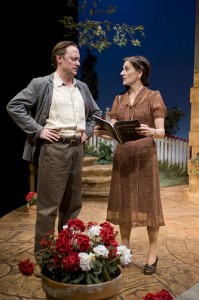 The Lunts are portrayed as two strong personalities who do not separate the theater from real life. As Lynn remarks, “We are always on stage.” They trade in larger than life emotions and seem to be performing even during their most intense personal moments. For them the theater is a miracle cure for all ailments, and dedication to the stage sweeps all of life’s other considerations aside.
The Lunts are portrayed as two strong personalities who do not separate the theater from real life. As Lynn remarks, “We are always on stage.” They trade in larger than life emotions and seem to be performing even during their most intense personal moments. For them the theater is a miracle cure for all ailments, and dedication to the stage sweeps all of life’s other considerations aside.
Carl and Louise are satellite figures who revolve around the Lunts’ sun. Carl is a lost soul who tries to make a living as a pool shark, grudgingly residing at Ten Chimneys year-round with his difficult, high maintenance mother. Louise is something of a family servant at Ten Chimneys; while her status remains lowly, she doesn’t bother to conceal her resentment.
Into this domestic hotbed come Uta Hagen and Sidney Greenstreet: Hagen is a young actress hired to play a leading role and she is immediately attracted to the charismatic Alfred Lunt, injecting some sexual frisson into the household that Lynn notes with unconcealed disapproval. Greenstreet is an outwardly hearty friend of the family, a moderately successful stage actor before becoming a star in Hollywood; he lives with the agony of a mentally ill wife permanently institutionalized a short distance from Ten Chimneys.
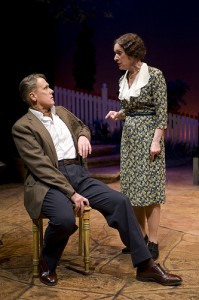 After the high comedy of the first act, the second act turns much darker. The high strung temperaments are unleashed into actions calculated to wound. Lynn wants Uta Hagen out of the show and Hattie plots against Lynn by raising the buried issue of whether Alfred had a homosexual relationship with an old friend now teaching at the University of Michigan. The jolly Greenstreet collapses under the weight of his blighted marriage and his own poor health, breaking into tears alone on the stage in one of the most moving bits I’ve seen in a play in a long time. By the end of the evening, everyone is pretty much as before, except that Hattie is slipping into senility. But the Lunt’s passion for the stage and for each other remain an unbreakable bond, making this work, along with its other merits, a convincing love story.
After the high comedy of the first act, the second act turns much darker. The high strung temperaments are unleashed into actions calculated to wound. Lynn wants Uta Hagen out of the show and Hattie plots against Lynn by raising the buried issue of whether Alfred had a homosexual relationship with an old friend now teaching at the University of Michigan. The jolly Greenstreet collapses under the weight of his blighted marriage and his own poor health, breaking into tears alone on the stage in one of the most moving bits I’ve seen in a play in a long time. By the end of the evening, everyone is pretty much as before, except that Hattie is slipping into senility. But the Lunt’s passion for the stage and for each other remain an unbreakable bond, making this work, along with its other merits, a convincing love story.
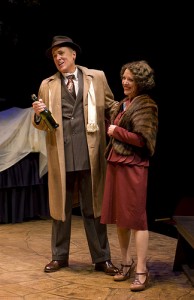 The performances at the Northlight are as scintillating as the dialogue. V. Craig Heidenreich is memorable as Alfred, his acting enhanced by his strong resemblance to the real Lunt. Lia Mortensen, English accent deftly in place, is splendid as Lynn Fontanne, a woman who can take no prisoners in a domestic or theatrical battle, but a woman with a bottomless love for the theater and for her husband. Fontanne was once asked if she had ever contemplated divorcing Lunt. She answered, “Murder, yes. Divorce, never.”
The performances at the Northlight are as scintillating as the dialogue. V. Craig Heidenreich is memorable as Alfred, his acting enhanced by his strong resemblance to the real Lunt. Lia Mortensen, English accent deftly in place, is splendid as Lynn Fontanne, a woman who can take no prisoners in a domestic or theatrical battle, but a woman with a bottomless love for the theater and for her husband. Fontanne was once asked if she had ever contemplated divorcing Lunt. She answered, “Murder, yes. Divorce, never.”
The supporting cast is impeccable. The find of the ensemble is the outstanding Sara Griffin as Uta Hagen, a young woman who enters wide-eyed and naive in the high stakes emotional game-playing that often afflicted the Lunt household. The only possible blemish is her age: Griffin seems in her mid-twenties, but at the time of the play, Hagen would be a teenager, reinforcing the character’s innocence in dealing with an experienced cut and thrust character like Lynn Fontanne. The same problem exists with Linda Kimbrough’s Hattie: she looks far too young to be the middle-aged Alfred’s mother, but Kimbrough still holds the stage beautifully with her waspish dialogue.
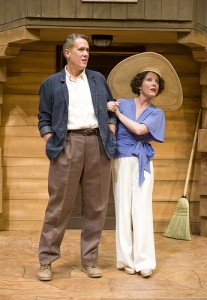 Steve Pringle delivers a wonderfully well-rounded performance as the corpulent Greenstreet, physically and emotionally. Lance Baker, who is having a superior season in local theater, portrays the disappointed and embittered Carl with a layer of sardonic humor that adds a dimension to this minor figure. Lastly, Janet Ulrich Brooks does a lovely job as the much put-upon and aggrieved Louise, trying to hold her own in the psychological thicket that frequently dominates the Lunt’s domestic life.
Steve Pringle delivers a wonderfully well-rounded performance as the corpulent Greenstreet, physically and emotionally. Lance Baker, who is having a superior season in local theater, portrays the disappointed and embittered Carl with a layer of sardonic humor that adds a dimension to this minor figure. Lastly, Janet Ulrich Brooks does a lovely job as the much put-upon and aggrieved Louise, trying to hold her own in the psychological thicket that frequently dominates the Lunt’s domestic life.
B.J. Jones does a marvelous job of directing the play in its many moods, including the rehearsal scenes of The Seagull, a master class in dramatic interpretation. Tom Burch designed the effective rural set that makes good use of the Northlight turntable stage. Rachel Laritz designed the costumes, JR Lederle the lighting, and Joe Cerqua the sound plus original music.
photos by Michael Brosilow
Ten Chimneys
Northlight Theatre
9501 Skokie Blvd in Skokie
ends on April 15, 2012
for tickets, call 847.673.6300 or visit Northlight Theatre
for more shows, visit Theatre in Chicago
